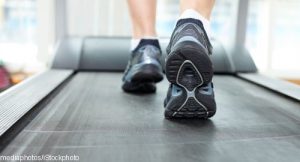 ATLANTA—To exercise or not to exercise? That’s a question without a simple answer for axial spondyloarthritis (axSpA) patients, according to Maureen Dubreuil, MD, MSc, Boston University School of Medicine and the VA Boston Healthcare System, and Laura Passalent, PT, MHSc, ACPAC, Toronto Western Hospital, University of Toronto and the Krembil Research Institute, Toronto, Canada. The two were speakers at the 2019 ACR/ARP Annual Meeting.
ATLANTA—To exercise or not to exercise? That’s a question without a simple answer for axial spondyloarthritis (axSpA) patients, according to Maureen Dubreuil, MD, MSc, Boston University School of Medicine and the VA Boston Healthcare System, and Laura Passalent, PT, MHSc, ACPAC, Toronto Western Hospital, University of Toronto and the Krembil Research Institute, Toronto, Canada. The two were speakers at the 2019 ACR/ARP Annual Meeting.
The pain, stiffness and fatigue that accompany ankylosing spondylitis (AS), radiographic axSpA (r-axSpA) and non-radiographic axSpA (nr-axSpA) are barriers and can discourage patients from exercising, the experts said. This can lead to a sedentary lifestyle and jeopardize patients’ overall health and well-being.
Even if patients are willing to exercise, they and their doctors face the dilemma of finding each patient’s Goldilocks zone, Dr. Dubreuil said. “Both too much exercise and not enough are not good. Low activity results in underuse and instability, and high activity results in overuse and damage, including inflammation of the entheses. Patients need to find what amount and kind of exercise are just right for them.”
The ACR and the Spondylitis Association of America/Spondyloarthritis Research and Treatment Network recently updated their joint recommendations for the treatment of AS and nr-axSpA. The authors of those recommendations:1
- Strongly recommend treatment with physical therapy over no treatment with physical therapy. These recommendations were from 2015 and were not reviewed in this update (level of evidence: moderate);
- Conditionally recommend active physical therapy interventions (supervised exercise) over passive physical therapy interventions (massage, ultrasound, heat) (level of evidence: very low);
- Conditionally recommend land-based physical therapy interventions over aquatic therapy interventions (level of evidence: moderate).
In Europe, the Assessment of SpondyloArthritis International Society and European Union League Against Rheumatism (ASAS-EULAR) management recommendations for axSpA, last updated in 2016, state, “Patients should be … encouraged to exercise on a regular basis; physical therapy should be considered.”2
“There are a few more caveats in the European guidelines,” Dr. Dubreuil said. She discussed three in particular:
- “In axSpA, it is known that home exercises are efficacious, and these are, therefore, recommended to patients.”
- “[P]hysical therapy is proven to be more efficacious than home exercises.”
- “Physiotherapy is certainly more expensive and less feasible than home exercises, but may be required [for] some patients.”
The Importance of Good Posture
“It’s important to keep in mind that posture is the foundation of function,” Ms. Passalent said. “Not all of our patients’ [spines] will fuse, but if they do, we want them to make sure they fuse in good posture.”
One approach she recommends is global postural re-education—an active and passive form of physiotherapy that focuses on stretching the anterior kinetic chain muscles. “We really need to try and open up the hip flexors, as well as the anterior trunk muscles and the posterior kinetic chain,” she said. This approach must be facilitated by a physiotherapist and can be used for a number of different spinal disorders, including axSpA.
A study published in 2017 found postural re-education was effective in reducing pain as well as improving function.3 “We know if we can keep our patients in good posture, it will minimize pain and maximize function,” Ms. Passalent said.
Ms. Passalent said exercise guidelines from the American College of Sports Medicine (ACSM) can be adapted for axSpA patients.4 She noted the EULAR recommendations are, to some degree, aligned with the ACSM’s. Specifically, they agree that physical activity should be part of a general plan to optimize health-related quality of life and offers health benefits for people with axSpA. They also agree on the four domains to target with exercise: cardiorespiratory fitness, muscle strength, flexibility and neuromotor performance.
Example: The ACSM recommends stretching major muscle groups two to three times weekly, with a 10- to 30-second hold, and at least two to four repetitions per muscle group. “We want to focus on soft tissue, as well as joint mobility for both the axial and peripheral joints,” Ms. Passalent said.
Strength Training Recommended
Another focus? Strength. “Everyone should do some form of strength training two to three times per week, with 10–15 repetitions for at least one set,” Ms. Passalent said. “We want to target the core muscle groups and also joint stability.
The hip abductors are a good example, because the gluteal muscles are very involved in supporting the hip, and people with ankylosing spondylitis are at higher risk of developing peripheral joint involvement, predominantly in the proximal large joints.
A recent Swedish study reported that a combination of cardiorespiratory and muscular strength exercises at high intensity over three months reduces disease activity.5 The 100 subjects ranged in age from their 20s to their 60s and were supervised two days per week by a physical therapist. The subjects exercised independently at home one day per week. A control group received standard care and maintained their usual physical activity level.
“High-intensity exercise reduced disease symptoms (pain, fatigue, stiffness) and also inflammation in patients with axSpA. It improved patients’ function and [cardiovascular] health. This debunks concerns that high-intensity exercise might exacerbate disease activity in patients with axSpA,” the researchers concluded.
It’s well known that patients with axSpA are at higher risk of developing cardiovascular events. “Of course we recommend behavioral changes, such as smoking cessation, but physical activity is also crucial,” Ms. Passalent said. The World Health Organization recommends 150 minutes of moderate-intensity aerobic activity per week, or at least 75 minutes of high-intensity aerobic activity per week, or a combination of the above, plus muscle strengthening activities at least twice per week.6
Although exercise can produce positive effects on a number of different outcomes in patients with axSpA, other factors must be considered when prescribing exercise for those individuals. For example, it’s important to understand the radiographic status of a patient before prescribing exercise. “If your patient has involvement only in the sacroiliac joints, I think on the whole you could probably be a little more liberal in terms of your exercise prescription,” Ms. Passalent said.
“However,” she warned, “if your patient has axial involvement, I think that’s where we become a little more conservative in terms of our exercise prescription.” Axial involvement, particularly if the patient has significant syndesmophytes or bamboo spine, will change the individual’s biomechanics, alter their center of mass and potentially create balance deficits. “We need to be aware of that because these patients are also at higher risk of vertebral fracture,” she said.
Although Dr. Dubreuil and Ms. Passalent recommend exercise for axSpA patients, they do so with caution because evidence is limited. “In most cases, we’re dealing with small sample sizes and variant patient populations,” Ms. Passalent said.
Mike Fillon is a healthcare writer living in the Atlanta area.
References
- Ward MM, Deodhar A, Gensler LS, et al. 2019 Update of the ACR/SAA/SPARTAN recommendations for the treatment of ankylosing spondylitis and nonradiogrpahic axial spondyloarthritis. Arthritis Care Res (Hoboken). 2019 Oct;71(10):1599–1613.
- van der Heijde D, Ramiro S, Landewé R, et al. 2016 update of the ASAS-EULAR management recommendations for axial spondyloarthritis. Ann Rheum Dis. 2017 Jun;76(6):978–991.
- Lomas-Vega R, Garrido-Jaut MV, Rus A. Effectiveness of global postural re-education for treatment of spinal disorders: A meta-analysis. Am J Phys Med Rehabil. 2017 Feb;96(2):124–130.
- Ewing Garber C, Blissmer B, Deschenes MR, et al. American College of Sports Medicine position stand. Quantity and quality of exercise for developing and maintaining cardiorespiratory, musculoskeletal, and neuromotor fitness in apparently healthy adults: Guidance for prescribing exercise. Med Sci Sports Exerc. 2011 Jul;43(7):1334–1359.
- Sveaas SH, Bilberg A, Berg IJ, et al. High intensity exercise for 3 months reduces disease activity in axial spondyloarthritis (axSpA): A multicentre randomised trial of 100 patients. Br J Sports Med. 2020 Mar;54(5):292–297.
- Global strategy on diet, physical activity and health: Physical activity and adults. World Health Organization. (n.d.)


